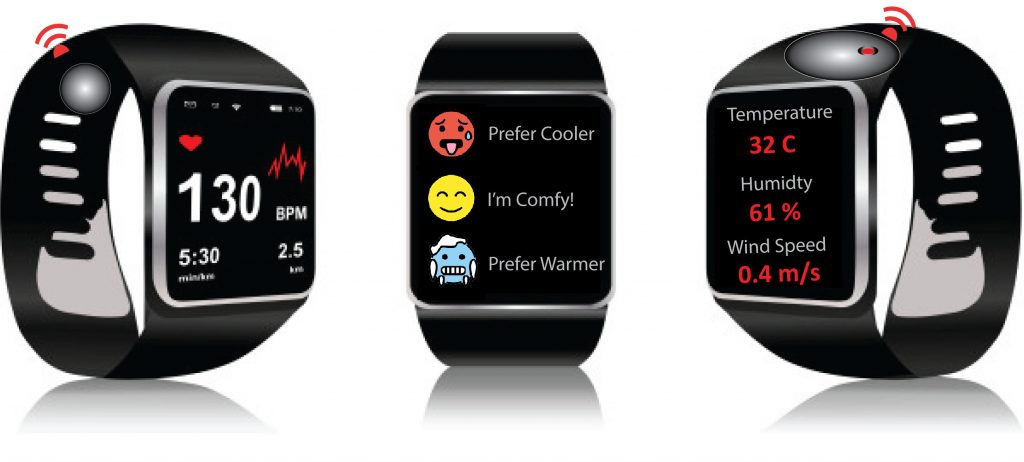Picture: Don’t stop me now. Credit: Maarten van den Heuvel (Unsplash).
Extreme heat events account for more deaths annually in Australia and the United States than any other natural disaster, but modern wearable devices offer the potential to reduce this death toll.
New research led by ARC Centre of Excellence for Climate Extremes researcher, Dr Negin Nazarian, reported in Environmental Research Letters has used Fitbit watches to estimate thermal comfort for individuals and recognise the changes to core body temperature that lead to heat stress.
The research is part of Project Coolbit, an ongoing investigation that aims to create a personalised approach to assessing thermal comfort and preventing health complications during extreme heat events. It’s research that could not only save the lives of individuals but may also change the way we design future cities.

“Currently, health warnings around heat stress only take into account external climatic factors like regional temperature and humidity but they fail to account for individual physiologies, our activities and extreme microclimates in built-environments caused by the urban heat island effect,” said Dr Nazarian.
“Wearable devices have the potential to capture all three, which means we may have a non-invasive way to predict heat stress before it happens, offer individual warnings and identify those parts of the urban environment that amplify already hot conditions in real time in considerable detail.”
The research was prompted by the lack of real-time, localised data around heat extremes, the amplifying impacts of the urban environment during these events and their effect on human physiology. Most research has instead focused on death and adverse health consequences “after” these events.
To test the possibilities of real-time measurements and to deliver an individual heat stress warning system the researchers added what they described as a wearable weather station to a Fitbit watch. This weather station records microclimate data (like air temperature and humidity), physiological readings (heart rate, skin temperature etc) and added subjective feedback where users described their thermal comfort and ability to undertake physical activity. They then tested these wearable weather stations in controlled environments inside and outside.
The results were promising. Body core temperature was measured to a high degree of accuracy, with 95% of results within 0.27°C and, importantly, the researchers were able to quantify the thermal comfort impact on human activity, with a direct connection between body temperature at the wrist and perceived activity level.
However, the one area where the watches struggled was accurately measuring ambient air temperature, due to the proximity of the watch’s sensors to the body. Costly sensors could overcome this issue, but the researchers are now trialling a novel method using heat exchange between the skin and atmosphere that could provide an inexpensive solution using the current sensor array.
If successful, the watches could be used by people from all walks of life, from the elderly and vulnerable with chronic conditions, through to physically active workers toiling in the open air on hot days. Should these watches become commonplace the data retrieved would also help urban planners better design built-environments to minimise the amplification of extreme heat events and impact a range of workplace policies.
“Our aim is to construct a human-centred approach to heat extremes that personalises a response regardless of age, body type, fitness levels, working environment or any of the range of human variables,” said Dr Nazarian.
“If we realise this goal, we can reduce the number of people who die from increasing common extreme heat events and build a rich and detailed dataset that will change the way we plan and build our cities and suburbs. These first steps show that this is not some distant blue-sky hope, it is a future that is tantalisingly already within our grasp.
Papers
- Nazarian, Negin, Sijie Liu, Manon Kohler, Jason Kai Wei Lee, Clayton Miller, Winston TL Chow, Sharifah Badriyah Badriyah Alhadad, et al. “Project Coolbit: Can Your Watch Predict Heat Stress and Thermal Comfort Sensation?” Environmental Research Letters, 2020. https://doi.org/10.1088/1748-9326/abd130.
- Nazarian, Negin, and Jason Kai Wei Lee. “Personal Assessment of Urban Heat Exposure: A Systematic Review.” Environmental Research Letters, 2020. https://doi.org/10.1088/1748-9326/abd350.
For more information or to arrange an interview with Dr Nazarian, please contact:
Alvin Stone
Media and Communications Manager
ARC Centre of Excellence for Climate Extremes
Email: alvin.stone@unsw.edu.au. Phone: +61 418 617 366.
